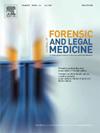Factors linked to juvenile delinquency among forced migrant children
IF 1.2
4区 医学
Q3 MEDICINE, LEGAL
引用次数: 0
Abstract
Purpose
Conditions of war have caused millions of children to be displaced both externally and internally worldwide. The present study aims to evaluate individual and trauma-caused risk factors and sociodemographic characteristics associated with juvenile delinquency among forced migrant children.
Methods
40 juvenile delinquents and 40 controls aged 13–17 who were forced migrants took part in the study. Schedule for Affective Disorders and Schizophrenia for School-Age Children, Harvard Trauma Scale, Strengths and Difficulties Scale, Multidimensional Scale of Perceived Social Support, Relationship Scales Questionnaire-Adolescent Form were administered to both groups. Chi-square test(x2) and Fisher's Exact test were used to compare categorical variables across two groups. Normality was assessed by Kolmogorov- Smirnov test. Normally distributed continuous variables were compared by the student's t-test whereas for non-normal continuous variables Mann-Whitney U test was used.
Results
Juvenile delinquency was related to larger family structure, lower socioeconomic and parental education levels, greater prevalence of smoking, alcohol, and substance use, and psychiatric diagnoses such MDD, PTSD, ADHD, ODD, DD among children. Traumatic migration experiences, longer migration periods, forced internal migration, having witnessed death or injury, not having attended school prior to migration, illiteracy, fragmented family structure, living apart from the parents, refugee camp experience, and were more prevalent among delinquents than non-delinquents.
Conclusions
These risk factors should be considered when designing prevention and intervention strategies and identifying protective factors to mitigate the negative effects of juvenile delinquency.
与被迫移民儿童中青少年犯罪有关的因素
战争条件已使全世界数百万儿童在国内外流离失所。本研究旨在评估与强迫流动儿童青少年犯罪相关的个体和创伤性风险因素及社会人口特征。方法选取40名13-17岁的青少年犯罪分子和40名被强迫迁移的青少年作为研究对象。两组分别采用《学龄期儿童情感障碍与精神分裂症量表》、《哈佛创伤量表》、《优势与困难量表》、《感知社会支持多维量表》、《青少年关系量表》进行问卷调查。两组间的分类变量比较采用卡方检验(x2)和Fisher’s Exact检验。用Kolmogorov- Smirnov检验评定正态性。正态分布的连续变量采用学生t检验,非正态分布的连续变量采用Mann-Whitney U检验。结果青少年犯罪与较大的家庭结构、较低的社会经济和父母教育水平、较高的吸烟、酗酒和药物使用患病率以及儿童精神疾病诊断(如MDD、PTSD、ADHD、ODD、DD)有关。创伤性移徙经历、较长的移徙期、被迫国内移徙、目睹死亡或受伤、移徙前没有上学、文盲、家庭结构破碎、与父母分居、难民营经历,这些问题在犯罪分子中比在非犯罪分子中更为普遍。结论在制定预防和干预策略时应充分考虑这些危险因素,确定保护因素,以减轻青少年犯罪的负面影响。
本文章由计算机程序翻译,如有差异,请以英文原文为准。
求助全文
约1分钟内获得全文
求助全文
来源期刊

Journal of forensic and legal medicine
MEDICINE, LEGAL-
CiteScore
2.70
自引率
6.70%
发文量
106
审稿时长
57 days
期刊介绍:
The Journal of Forensic and Legal Medicine publishes topical articles on aspects of forensic and legal medicine. Specifically the Journal supports research that explores the medical principles of care and forensic assessment of individuals, whether adult or child, in contact with the judicial system. It is a fully peer-review hybrid journal with a broad international perspective.
The Journal accepts submissions of original research, review articles, and pertinent case studies, editorials, and commentaries in relevant areas of Forensic and Legal Medicine, Context of Practice, and Education and Training.
The Journal adheres to strict publication ethical guidelines, and actively supports a culture of inclusive and representative publication.
 求助内容:
求助内容: 应助结果提醒方式:
应助结果提醒方式:


